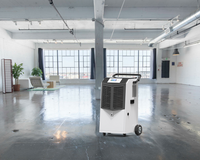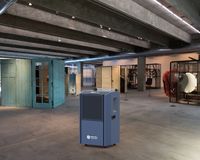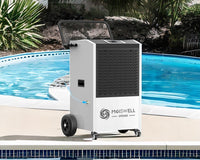Growing plants indoors, whether for personal use or commercial cultivation, offers many advantages, including year-round production and precise environmental control. However, one critical factor that indoor growers must manage is humidity. Maintaining the right humidity level in your indoor grow room, with the help of a commercial dehumidifier, is essential for the health and productivity of your plants. In this article, we'll explore the importance of humidity control in indoor cultivation and provide practical tips on how to achieve optimal humidity levels for your indoor grow room using a commercial dehumidifier.
The Importance of Humidity Control:
Humidity plays a pivotal role in the growth and development of plants. It affects various aspects of plant health, including transpiration, nutrient uptake, and susceptibility to diseases. Here are some key reasons why humidity control with a commercial dehumidifier is vital in an indoor grow room:
Transpiration: Plants transpire, releasing moisture through small openings in their leaves called stomata. Proper humidity levels ensured by a commercial dehumidifier ensure that transpiration rates are balanced, allowing plants to take up water and nutrients efficiently.
Disease Prevention: High humidity can create a favorable environment for fungal diseases like powdery mildew and botrytis. Controlling humidity with a commercial dehumidifier reduces the risk of these diseases and helps maintain plant health.
Optimal Growth: Different plant species have specific humidity requirements during various growth stages. Maintaining the right humidity levels with a commercial dehumidifier ensures that your plants grow at their best, producing healthier foliage and higher yields.
Temperature Regulation: Humidity can influence temperature perception in plants. Proper humidity control with a commercial dehumidifier can help regulate plant temperature, preventing stress and promoting steady growth.
Tips for Controlling Humidity in Your Indoor Grow Room:
Invest in a Dehumidifier
Commercial dehumidifiers are highly effective tools for controlling humidity in indoor grow rooms. Choose a dehumidifier with the capacity to handle the size of your grow room. Look for models that allow you to set and maintain specific humidity levels.
Use Fans and Ventilation
Proper air circulation is crucial for humidity control. Use exhaust fans and ventilation systems to ensure that moist air is continuously removed from the grow room. This also helps maintain a uniform climate for your plants.
Monitor Humidity Levels
Install a hygrometer or humidity monitor in your grow room to keep a constant eye on humidity levels. This allows you to adjust your humidity control systems as needed.
Watering Practices
Adjust your watering schedule to align with humidity control. Overwatering can raise humidity levels, so water your plants when the lights are on and the room temperature is rising, allowing excess moisture to be absorbed.
Humidifiers for Low Humidity
In some cases, especially during the winter months, indoor grow rooms may experience low humidity. In such instances, using a humidifier can help raise humidity levels to the desired range.
How to Control Humidity in Your Indoor Grow Room?





